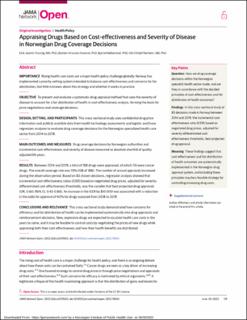| dc.contributor.author | Tranvåg, Eirik Joakim | |
| dc.contributor.author | Haaland, Øystein Ariansen | |
| dc.contributor.author | Robberstad, Bjarne | |
| dc.contributor.author | Norheim, Ole Frithjof | |
| dc.date.accessioned | 2022-07-01T08:53:43Z | |
| dc.date.available | 2022-07-01T08:53:43Z | |
| dc.date.created | 2022-06-30T14:29:24Z | |
| dc.date.issued | 2022 | |
| dc.identifier.issn | 2574-3805 | |
| dc.identifier.uri | https://hdl.handle.net/11250/3002014 | |
| dc.description.abstract | Importance: Rising health care costs are a major health policy challenge globally. Norway has implemented a priority-setting system intended to balance cost-effectiveness and concerns for fair distribution, but little is known about this strategy and whether it works in practice.
Objective: To present and evaluate a systematic drug appraisal method that uses the severity of disease to account for a fair distribution of health in cost-effectiveness analysis, forming the basis for price negotiations and coverage decisions.
Design, Setting, and Participants: This cross-sectional study uses confidential drug price information and publicly available data from health technology assessments and logistic and linear regression analyses to evaluate drug coverage decisions for the Norwegian specialized health care sector from 2014 to 2019.
Main Outcomes and Measures: Drug coverage decisions by Norwegian authorities and incremental cost-effectiveness and severity of disease measured as absolute shortfall of quality adjusted life years.
Results: Between 2014 and 2019, a total of 188 drugs were appraised, of which 113 were cancer drugs. The overall coverage rate was 73% (138 of 188). The number of annual appraisals increased during the observation period. Based on 83 chosen decisions, regression analysis showed that incremental cost-effectiveness ratios (ICER) based on negotiated drug prices, adjusted for severity-differentiated cost-effectiveness thresholds, was the variable that best projected drug approvals (OR, 0.60; 95% CI, 0.42-0.86). An increase in the ICER by $10 000 was associated with a reduction in the odds for approval of 40% for drugs assessed from 2018 to 2019.
Conclusions and Relevance: This cross-sectional study demonstrated how concerns for efficiency and fair distribution of health can be implemented systematically into drug appraisals and reimbursement decisions. New, expensive drugs are expected to escalate health care costs in the years to come, and it may be feasible to control costs by negotiating the prices of new drugs while appraising both their cost-effectiveness and how their health benefits are distributed. | en_US |
| dc.language.iso | eng | en_US |
| dc.publisher | American Medical Association | en_US |
| dc.rights | Navngivelse 4.0 Internasjonal | * |
| dc.rights.uri | http://creativecommons.org/licenses/by/4.0/deed.no | * |
| dc.title | Appraising Drugs Based on Cost-effectiveness and Severity of Disease in Norwegian Drug Coverage Decisions | en_US |
| dc.type | Journal article | en_US |
| dc.type | Peer reviewed | en_US |
| dc.description.version | publishedVersion | en_US |
| dc.rights.holder | Copyright 2022 the authors | en_US |
| dc.source.articlenumber | e2219503 | en_US |
| cristin.ispublished | true | |
| cristin.fulltext | original | |
| cristin.qualitycode | 1 | |
| dc.identifier.doi | https://doi.org/10.1001/jamanetworkopen.2022.19503 | |
| dc.identifier.cristin | 2036397 | |
| dc.source.journal | JAMA Network Open | en_US |
| dc.identifier.citation | JAMA Network Open. 2022, 5 (6), e2219503. | en_US |
| dc.source.volume | 5 | en_US |
| dc.source.issue | 6 | en_US |

